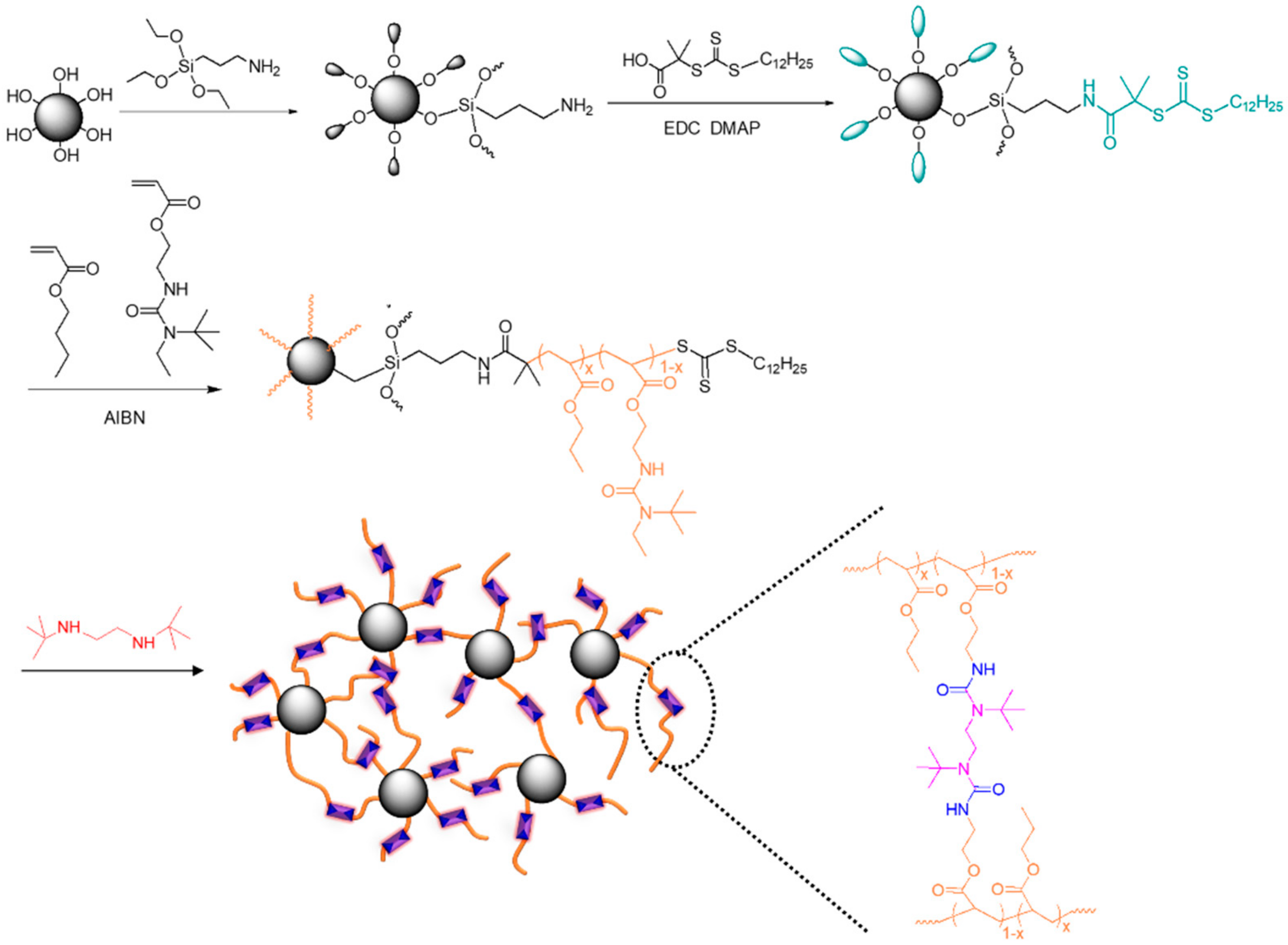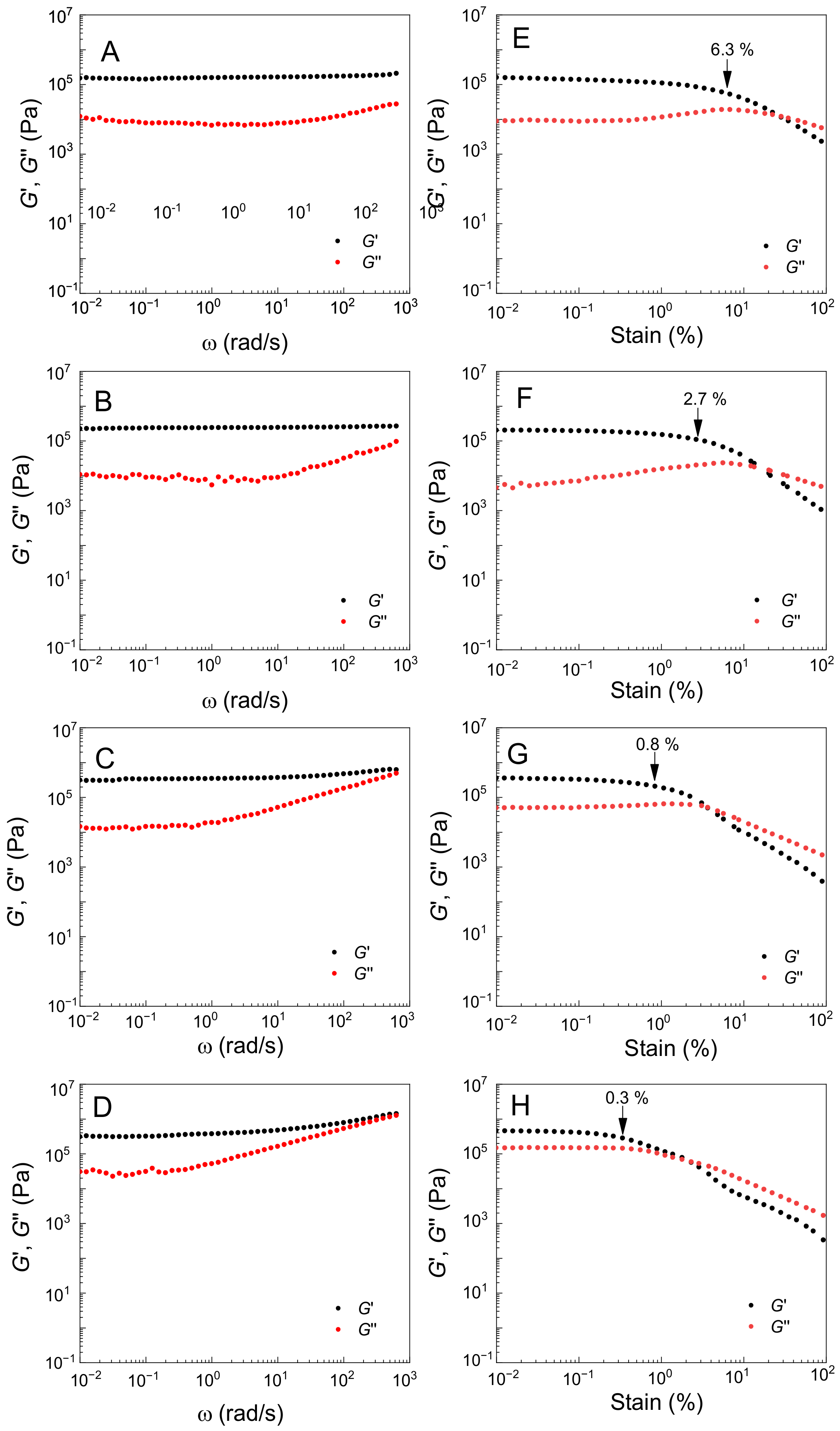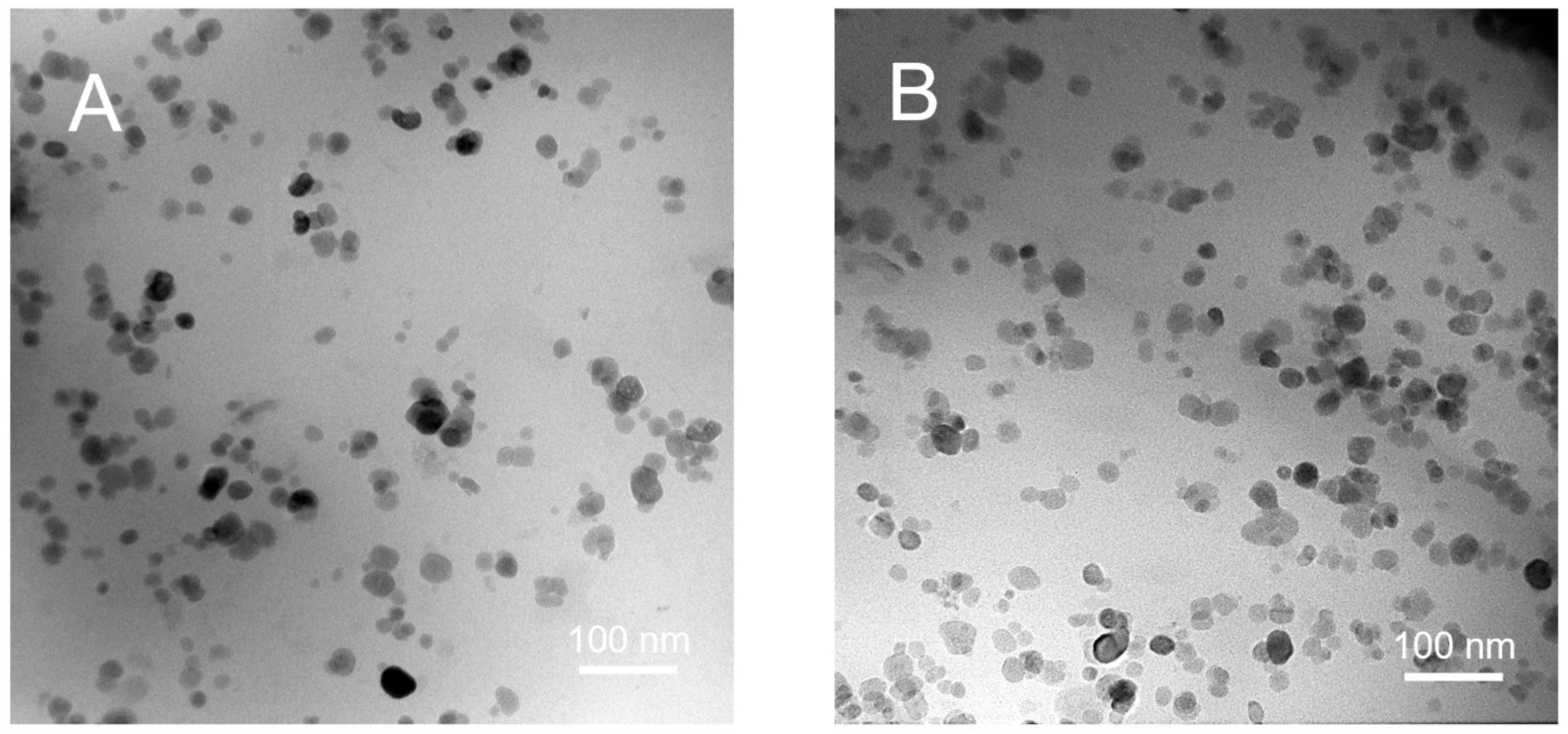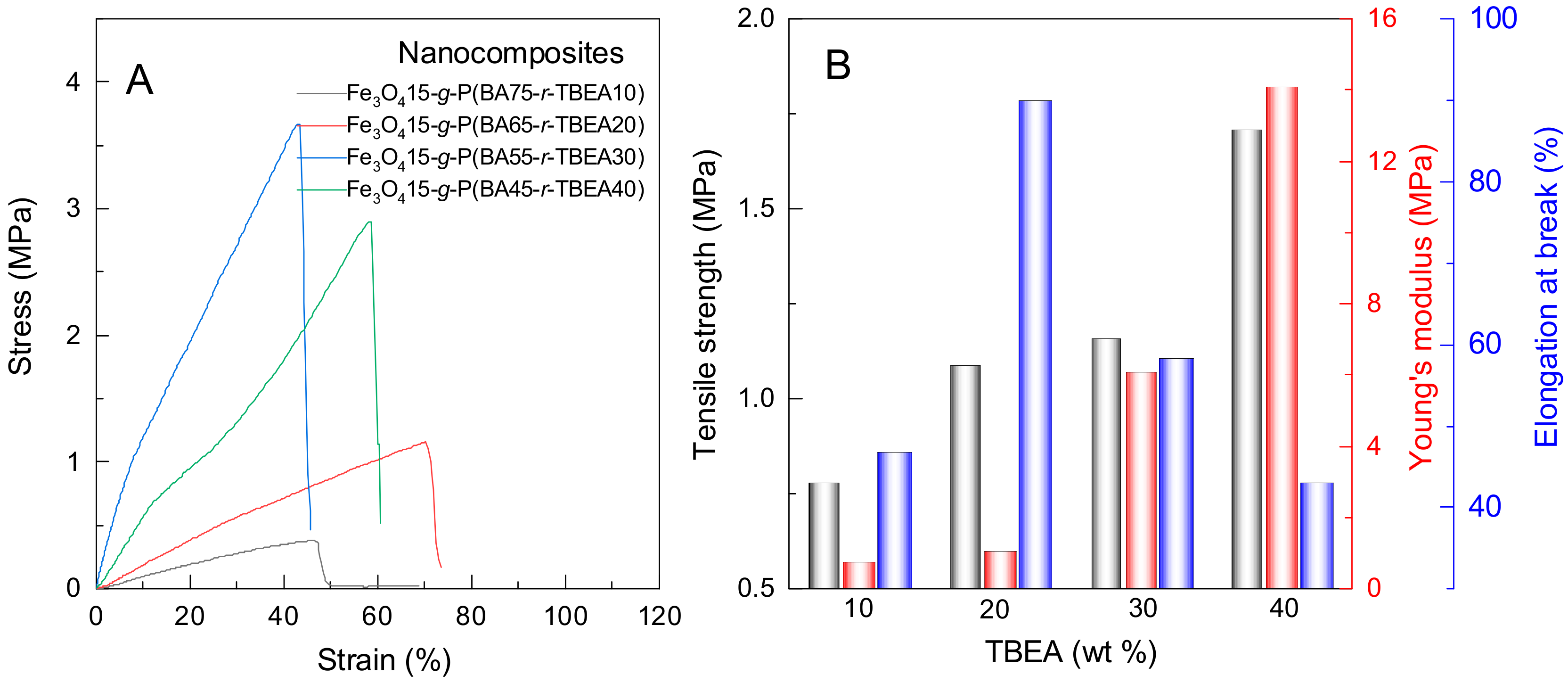Nanocomposites of Poly(n-Butyl Acrylate) with Fe3O4: Crosslinking with Hindered Urea Bonds, Reprocessing and Related Functional Properties
Abstract
:1. Introduction
2. Experimental
2.1. Materials
2.2. Synthesis of Fe3O4-g-P(BA-r-TBEA)
2.3. Crosslinking of Fe3O4-g-P(BA-r-TBEA)
3. Results and Discussion
3.1. Synthesis of Fe3O4-g-P(BA-r-TBEA)
3.2. Crosslinking of Fe3O4-g-P(BA-r-TBEA) with HUBs
3.3. Thermal and Mechanical Properties
3.4. Magnetic Properties
3.5. Reprocessing Properties
3.6. Multi-Stimuli-Responsive Shape Memory Properties
4. Conclusions
Supplementary Materials
Author Contributions
Funding
Institutional Review Board Statement
Data Availability Statement
Conflicts of Interest
References
- Rozenberg, B.A.; Tenne, R. Polymer-assisted fabrication of nanoparticles and nanocomposites. Prog. Polym. Sci. 2008, 33, 40–112. [Google Scholar] [CrossRef]
- Singh, S.; Chen, H.; Shahrokhi, S.; Wang, L.; Lin, C.; Hu, L.; Guan, X.; Tricoli, A.; Xu, Z.; Wu, T. Hybrid organic-inorganic materials and composites for photoelectrochemical water splitting. ACS Energy Lett. 2020, 5, 1487–1497. [Google Scholar] [CrossRef]
- Yi, Z.; Wang, Z.; Wu, D.; Xue, Y. Novel compositions and architectures of organic-inorganic layered composites with ultrahigh energy storage density and excellent thermal stability. Compos. Commun. 2023, 37, 101408. [Google Scholar] [CrossRef]
- Liu, S.; Yu, B.; Wang, S.; Shen, Y.; Cong, H. Preparation, surface functionalization and application of Fe3O4 magnetic nanoparticles. Adv. Colloid Interface Sci. 2020, 281, 102165. [Google Scholar] [CrossRef]
- Wei, Y.; Han, B.; Hu, X.; Lin, Y.; Wang, X.; Deng, X. Synthesis of Fe3O4 nanoparticles and their magnetic properties. Procedia Eng. 2012, 27, 632–637. [Google Scholar] [CrossRef]
- Kou, Z.; Hu, Y.; Ma, Y.; Yuan, L.; Hu, L.; Zhou, Y.; Jia, P. Bio-based dynamically crosslinked networks/Fe3O4 nanoparticles composites with self-healing ability driven by multiple stimuli for non-contact welding. Ind. Crop. Prod. 2023, 195, 116401. [Google Scholar] [CrossRef]
- S, H.; Sambhudevan, S. Ferrite-based polymer nanocomposites as shielding materials: A review. Chem. Pap. 2021, 75, 3697–3710. [Google Scholar] [CrossRef]
- Makabenta, J.M.V.; Nabawy, A.; Li, C.; Schmidt-Malan, S.; Patel, R.; Rotello, V.M. Nanomaterial-based therapeutics for antibiotic-resistant bacterial infections. Nat. Rev. Microbiol. 2021, 19, 23–36. [Google Scholar] [CrossRef]
- Li, L.; Zheng, S. Poly(ε-caprolactone)-grafted Fe3O4 nanoparticles: Preparation and superparamagnetic nanocomposites with epoxy thermosets. Ind. Eng. Chem. Res. 2015, 54, 171–180. [Google Scholar] [CrossRef]
- Kohler, N.; Fryxell, G.E.; Zhang, M. A bifunctional poly(ethylene glycol) silane immobilized on metallic oxide-based nanoparticles for conjugation with cell targeting agents. J. Am. Chem. Soc. 2004, 126, 7206–7211. [Google Scholar] [CrossRef]
- Gupta, A.K.; Gupta, M. Synthesis and surface engineering of iron oxide nanoparticles for biomedical applications. Biomaterials 2005, 26, 3995–4021. [Google Scholar] [CrossRef] [PubMed]
- Zhou, Y.; Wang, S.; Xie, K.; Dai, Y.; Ma, W. Versatile functionalization of Fe3O4 nanoparticles via RAFT polymerization and click chemistry. Appl. Surf. Sci. 2011, 257, 10384–10389. [Google Scholar] [CrossRef]
- Li, Y.; Dong, M.; Kong, J.; Chai, Z.; Fu, G. Synthesis of Fe3O4@poly(methacrylic acid) core-shell submicrospheres via RAFT precipitation polymerization. J. Colloid Interface Sci. 2013, 394, 199–207. [Google Scholar] [CrossRef] [PubMed]
- Massoumi, B.; Mousavi-Hamamlu, S.V.; Ghamkhari, A.; Jaymand, M. A novel strategy for synthesis of polystyrene/Fe3O4 nanocomposite: RAFT polymerization, functionalization, and coordination techniques. Polym. Plast. Technol. Eng. 2017, 56, 873–882. [Google Scholar] [CrossRef]
- Li, L.; Zhao, B.; Wang, H.; Gao, Y.; Hu, J.; Zheng, S. Nanocomposites of polyhydroxyurethane with Fe3O4 nanoparticles: Synthesis, shape memory and reprocessing properties. Compos. Sci. Technol. 2021, 215, 109009. [Google Scholar] [CrossRef]
- Xu, S.; Zhao, B.; Adeel, M.; Mei, H.; Li, L.; Zheng, S. Shape memory and self-healing properties of polymer-grafted Fe3O4 nanocomposites implemented with supramolecular quadruple hydrogen bonds. Polymer 2019, 172, 404–414. [Google Scholar] [CrossRef]
- Huang, S.; Kong, X.; Xiong, Y.; Zhang, X.; Chen, H.; Jiang, W.; Niu, Y.; Xu, W.; Ren, C. An overview of dynamic covalent bonds in polymer material and their applications. Eur. Polym. J. 2020, 141, 110094. [Google Scholar] [CrossRef]
- Sakamaki, D.; Ghosh, S.; Seki, S. Dynamic covalent bonds: Approaches from stable radical species. Mater. Chem. Front. 2019, 3, 2270–2282. [Google Scholar] [CrossRef]
- Chakma, P.; Konkolewicz, D. Dynamic covalent bonds in polymeric materials. Angew. Chem. Int. Ed. 2019, 58, 9682–9695. [Google Scholar] [CrossRef]
- Wu, J.; Stoddart, J.F. Mechanical bonds and dynamic covalent bonds. Mater. Chem. Front. 2020, 4, 1553. [Google Scholar] [CrossRef]
- Webber, M.J.; Tibbitt, M.W. Dynamic and reconfigurable materials from reversible network interactions. Nat. Rev. Mater. 2022, 7, 541–556. [Google Scholar] [CrossRef]
- Chen, M.; Wu, Y.; Chen, B.; Tucker, A.M.; Jagota, A.; Yang, S. Fast, strong, and reversible adhesives with dynamic covalent bonds for potential use in wound dressing. Proc. Natl. Acad. Sci. USA 2022, 119, 2203074119. [Google Scholar] [CrossRef] [PubMed]
- Samanta, S.; Kim, S.; Saito, T.; Sokolov, A.P. Polymers with dynamic bonds: Adaptive functional materials for a sustainable future. J. Phys. Chem. B 2021, 125, 9389–9401. [Google Scholar] [CrossRef] [PubMed]
- Montarna, D.; Capelot, M.; Tournilhac, F.; Leibler, L. Silica-like malleable materials from permanent organic networks. Science 2011, 334, 965–968. [Google Scholar] [CrossRef]
- Ji, F.; Liu, X.; Sheng, D.; Yang, Y. Epoxy-vitrimer composites based on exchangeable aromatic disulfide bonds: Reprocessibility, adhesive, multi-shape memory effect. Polymer 2020, 197, 122514. [Google Scholar] [CrossRef]
- Di Mauro, C.; Malburet, S.; Graillot, A.; Mija, A. Recyclable, repairable, and reshapable (3R) thermoset materials with shape memory properties from bio-based epoxidized vegetable oils. ACS Appl. Bio Mater. 2020, 3, 8094–8104. [Google Scholar] [CrossRef]
- Chen, M.; Zhou, L.; Wu, Y.; Zhao, X.; Zhang, Y. Rapid stress relaxation and moderate temperature of malleability enabled by the synergy of disulfide metathesis and carboxylate transesterification in epoxy vitrimers. ACS Macro Lett. 2019, 8, 255–260. [Google Scholar] [CrossRef]
- Liu, X.; Liang, L.; Lu, M.; Song, X.; Liu, H.; Chen, G. Water-resistant bio-based vitrimers based on dynamic imine bonds: Self-healability, remodelability and ecofriendly recyclability. Polymer 2020, 210, 123030. [Google Scholar] [CrossRef]
- Liu, Y.; Tang, Z.; Chen, J.; Xiong, J.; Wang, D.; Wang, S.; Wu, S.; Guo, B. Tuning the mechanical and dynamic properties of imine bond crosslinked elastomeric vitrimers by manipulating the crosslinking degree. Polym. Chem. 2020, 11, 1348–1355. [Google Scholar] [CrossRef]
- Liguori, A.; Hakkarainen, M. Designed from biobased materials for recycling: Imine-based covalent adaptable networks. Macromol. Rapid Commun. 2022, 43, 2100816. [Google Scholar] [CrossRef]
- Lu, Y.; Guan, Z. Olefin metathesis for effective polymer healing via dynamic exchange of strong carbon-carbon double bonds. J. Am. Chem. Soc. 2012, 134, 14226–14231. [Google Scholar] [CrossRef] [PubMed]
- Luo, J.; Demchuk, Z.; Zhao, X.; Saito, T.; Tian, M.; Sokolov, A.P.; Cao, P. Elastic vitrimers: Beyond thermoplastic and thermoset elastomers. Matter 2022, 5, 1391–1422. [Google Scholar] [CrossRef]
- Röttger, M.; Domenech, T.; van der Weegen, R.; Breuillac, A.; Nicolaÿ, R.; Leibler, L. High-performance vitrimers from commodity thermoplastics through dioxaborolane metathesis. Science 2017, 356, 62–65. [Google Scholar] [CrossRef] [PubMed]
- Zhang, X.; Wang, S.; Jiang, Z.; Li, Y.; Jing, X. Boronic ester based vitrimers with enhanced stability via internal boron-nitrogen coordination. J. Am. Chem. Soc. 2020, 142, 21852–21860. [Google Scholar] [CrossRef] [PubMed]
- Song, K.; Ye, W.; Gao, X.; Fang, H.; Zhang, Y.; Zhang, Q.; Li, X.; Yang, S.; Wei, H.; Ding, Y. Synergy between dynamic covalent boronic ester and boron-nitrogen coordination: Strategy for self-healing polyurethane elastomers at room temperature with unprecedented mechanical properties. Mater. Horiz. 2021, 8, 216–223. [Google Scholar] [CrossRef]
- Gao, T.; Lu, H.; Gao, P.; Li, B. Enantioselective synthesis of tertiary boronic esters through catalytic asymmetric reversed hydroboration. Nat. Commun. 2021, 12, 3776. [Google Scholar] [CrossRef]
- Hu, S.; Chen, X.; Torkelson, J.M. Biobased reprocessable polyhydroxyurethane networks: Full recovery of crosslink density with three concurrent dynamic chemistries. ACS Sustain. Chem. Eng. 2019, 7, 10025–10034. [Google Scholar] [CrossRef]
- Fortman, D.J.; Brutman, J.P.; Cramer, C.J.; Hillmyer, M.A.; Dichtel, W.R. Mechanically activated, catalyst-free polyhydroxyurethane vitrimers. J. Am. Chem. Soc. 2015, 137, 14019–14022. [Google Scholar] [CrossRef]
- Gablier, A.; Saed, M.O.; Terentjev, E.M. Rates of transesterification in epoxy-thiol vitrimers. Soft Matter 2020, 16, 5195–5202. [Google Scholar] [CrossRef]
- Weerathaworn, S.; Abetz, V. Tailor-made vinylogous urethane vitrimers based on binary and ternary block and random copolymers: An approach toward reprocessable materials. Macromol. Chem. Phys. 2023, 224, 2200248. [Google Scholar] [CrossRef]
- Xu, H.; Wang, H.; Zhang, Y.; Wu, J. Vinylogous urethane based epoxy vitrimers with closed-loop and multiple recycling routes. Ind. Eng. Chem. Res. 2022, 61, 17524–17533. [Google Scholar] [CrossRef]
- Denissen, W.; Droesbeke, M.; Nicolaÿ, R.; Leibler, L.; Winne, J.M.; Du Prez, F.E. Chemical control of the viscoelastic properties of vinylogous urethane vitrimers. Nat. Commun. 2017, 8, 14857. [Google Scholar] [CrossRef] [PubMed]
- Ying, H.; Zhang, Y.; Cheng, J. Dynamic urea bond for the design of reversible and self-healing polymers. Nat. Commun. 2014, 5, 3218. [Google Scholar] [CrossRef] [PubMed]
- Zhou, Z.; Wang, X.; Yu, H.; Yu, C.; Zhang, F. Dynamic cross-linked polyurea/polydopamine nanocomposites for photoresponsive self-healing and photoactuation. Macromolecules 2022, 55, 2193–2201. [Google Scholar] [CrossRef]
- Wang, H.; Hang, G.; Mei, H.; Li, L.; Zheng, S. Crosslinking of poly(n-butyl acrylate)-POSS copolymers via dynamic urea exchange enables self-healing, reprocessing and shape recovery. Polym. Chem. 2023, 14, 872–887. [Google Scholar] [CrossRef]
- Yang, Y.; Ying, H.; Li, Z.; Wang, J.; Chen, Y.; Luo, B.; Gray, D.L.; Ferguson, A.; Chen, Q.; Cheng, Y. Near quantitative synthesis of urea macrocycles enabled by bulky N-substituent. Nat. Commun. 2012, 12, 1572. [Google Scholar] [CrossRef]
- Xia, Y.; Song, Z.; Tan, Z.; Xue, T.; Wei, S.; Zhu, L.; Yang, Y.; Fu, H.; Jiang, Y.; Lin, Y.; et al. Accelerated polymerization of N-carboxyanhydrides catalyzed by crown ether. Nat. Commun. 2021, 12, 732. [Google Scholar] [CrossRef]
- Yang, Y.; Ying, H.; Jia, Y.; Chen, Y.; Cheng, J. Stabilization of the hindered urea bond through de-tert-butylation. Chem. Commun. 2021, 57, 3812–3815. [Google Scholar] [CrossRef]
- Ding, H.; Zhao, B.; Mei, H.; Li, L.; Zheng, S. Transformation of commodity poly(hydroxyether of bisphenol A) into vitrimers via post crosslinking with hindered urea bonds. Chinese J. Polym. Sci. 2020, 38, 915–920. [Google Scholar] [CrossRef]
- Zhao, B.; Li, L.; Hu, J.; Wang, H.; Mei, H.; Zheng, S. Self-healable and reprocessable networks involving diblock copolymer and hindered urea bonds. Polymer 2022, 242, 124591. [Google Scholar] [CrossRef]
- Kostenko, M.; Stetsyshyn, Y.; Harhay, K.; Melnyk, Y.; Donchak, V.; Gubriy, Z.; Kracalik, M. Impact of the functionalized clay nanofillers on the properties of the recycled polyethylene terephthalate nanocomposites. J. Appl. Polym. Sci. 2024, 141, 55543. [Google Scholar] [CrossRef]
- Wåhlander, M.; Nilsson, F.; Larsson, E.; Tsai, W.; Hillborg, H.; Carlmark, A.; Gedde, U.W.; Malmström, E. Polymer-grafted Al2O3-nanoparticles for controlled dispersion in poly(ethylene-co-butyl acrylate) nanocomposites. Polymer 2014, 55, 2125–2138. [Google Scholar] [CrossRef]
- Newcomb, M.; Varick, T.R.; Goh, S. Mechanism of reduction of trityl halides by lithiumdialkylamide bases. J. Am. Chem. Soc. 1990, 112, 5186–5193. [Google Scholar] [CrossRef]
- Wang, R.; McCormick, C.L.; Lowe, A.B. Synthesis and evaluation of new dicarboxylic acid functional trithiocarbonates: RAFT synthesis of telechelic poly(n-butyl acrylate)s. Macromolecules 2005, 38, 9518–9525. [Google Scholar] [CrossRef]
- Huang, J.; Fan, J.; Yin, S.; Chen, Y. Design of remotely, locally triggered shape-memory materials based on bicontinuous polylactide/epoxidized natural rubber thermoplastic vulcanizates via regulating the distribution of ferroferric oxide. Compos. Sci. Technol. 2019, 182, 107732. [Google Scholar] [CrossRef]
- Huang, J.; Cao, L.; Yuan, D.; Chen, Y. Design of multi-stimuli-responsive shape memory biobased PLA/ENR/Fe3O4 TPVs with balanced stiffness-toughness based on selective distribution of Fe3O4. ACS Sustain. Chem. Eng. 2019, 7, 2304–2315. [Google Scholar] [CrossRef]
- Gu, S.; Jin, S.; Gao, X.; Mu, J. Polylactide-based polyurethane shape memory nanocomposites (Fe3O4/PLAUs) with fast magnetic responsiveness. Smart Mater. Struct. 2016, 25, 055036. [Google Scholar] [CrossRef]
- Yu, K.; Westbrook, K.K.; Kao, P.; Leng, J.; Qi, H. 2012 Design considerations for shape memory polymer composites with megnatic particles. J. Compos. Mater. 2012, 47, 51–63. [Google Scholar] [CrossRef]
- Pekdemir, M.E.; Aydin, D.; Selçuk Pekdemir, S.; Erecevit Sönmez, P.; Aksoy, E. Shape memory polymer-based nanocomposites magnetically enhanced with Fe3O4 nanoparticles. J. Inorg. Organomet. Polym. 2023, 33, 1147–1155. [Google Scholar] [CrossRef]
- Razzaq, M.Y.; Anhalt, M.; Frormann, L.; Weidenfeller, B. Thermal, electrical and magnetic studies of magnetite filled polyurethane shape memory polymers. Mater. Sci. Eng. A 2007, 444, 227–235. [Google Scholar] [CrossRef]










Disclaimer/Publisher’s Note: The statements, opinions and data contained in all publications are solely those of the individual author(s) and contributor(s) and not of MDPI and/or the editor(s). MDPI and/or the editor(s) disclaim responsibility for any injury to people or property resulting from any ideas, methods, instructions or products referred to in the content. |
© 2024 by the authors. Licensee MDPI, Basel, Switzerland. This article is an open access article distributed under the terms and conditions of the Creative Commons Attribution (CC BY) license (https://creativecommons.org/licenses/by/4.0/).
Share and Cite
Li, L.; Wang, H.; Shen, X.; Hang, G.; Gao, Y.; Hu, J.; Zheng, S. Nanocomposites of Poly(n-Butyl Acrylate) with Fe3O4: Crosslinking with Hindered Urea Bonds, Reprocessing and Related Functional Properties. Polymers 2024, 16, 2638. https://doi.org/10.3390/polym16182638
Li L, Wang H, Shen X, Hang G, Gao Y, Hu J, Zheng S. Nanocomposites of Poly(n-Butyl Acrylate) with Fe3O4: Crosslinking with Hindered Urea Bonds, Reprocessing and Related Functional Properties. Polymers. 2024; 16(18):2638. https://doi.org/10.3390/polym16182638
Chicago/Turabian StyleLi, Lei, Huaming Wang, Xibin Shen, Guohua Hang, Yuan Gao, Jiawei Hu, and Sixun Zheng. 2024. "Nanocomposites of Poly(n-Butyl Acrylate) with Fe3O4: Crosslinking with Hindered Urea Bonds, Reprocessing and Related Functional Properties" Polymers 16, no. 18: 2638. https://doi.org/10.3390/polym16182638
APA StyleLi, L., Wang, H., Shen, X., Hang, G., Gao, Y., Hu, J., & Zheng, S. (2024). Nanocomposites of Poly(n-Butyl Acrylate) with Fe3O4: Crosslinking with Hindered Urea Bonds, Reprocessing and Related Functional Properties. Polymers, 16(18), 2638. https://doi.org/10.3390/polym16182638







